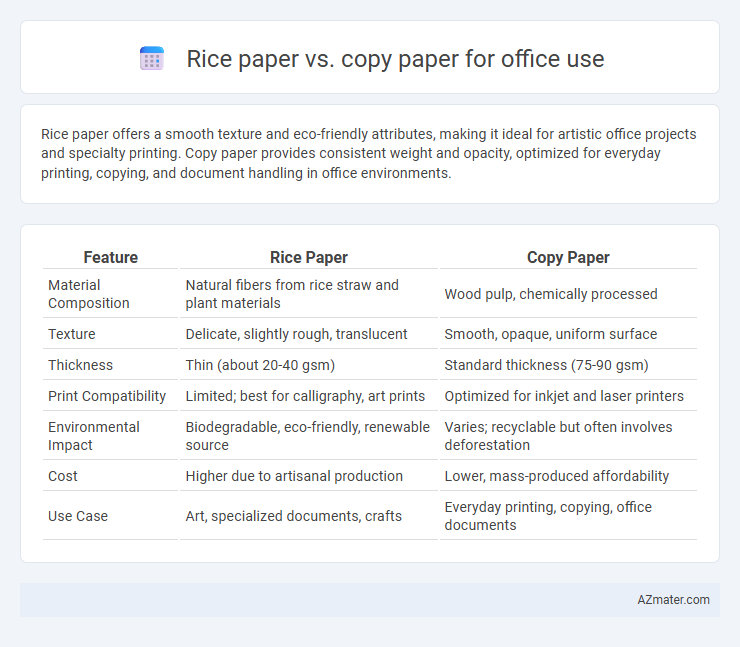Rice paper offers a smooth texture and eco-friendly attributes, making it ideal for artistic office projects and specialty printing. Copy paper provides consistent weight and opacity, optimized for everyday printing, copying, and document handling in office environments.
Table of Comparison
| Feature | Rice Paper | Copy Paper |
|---|---|---|
| Material Composition | Natural fibers from rice straw and plant materials | Wood pulp, chemically processed |
| Texture | Delicate, slightly rough, translucent | Smooth, opaque, uniform surface |
| Thickness | Thin (about 20-40 gsm) | Standard thickness (75-90 gsm) |
| Print Compatibility | Limited; best for calligraphy, art prints | Optimized for inkjet and laser printers |
| Environmental Impact | Biodegradable, eco-friendly, renewable source | Varies; recyclable but often involves deforestation |
| Cost | Higher due to artisanal production | Lower, mass-produced affordability |
| Use Case | Art, specialized documents, crafts | Everyday printing, copying, office documents |
Introduction to Rice Paper and Copy Paper
Rice paper, traditionally made from rice straw or other natural fibers, offers a unique texture and lightweight quality often used in calligraphy and artistic prints. Copy paper, typically made from wood pulp with standard weight and brightness, is designed for everyday office printing and copying tasks, ensuring smooth ink absorption and compatibility with most printers. Understanding the differences in fiber content and intended use helps optimize paper choice for specific office needs.
Composition and Manufacturing Differences
Rice paper is made primarily from the inner bark fibers of the rice plant or other plants like mulberry, resulting in a delicate, fibrous texture ideal for artistic and traditional uses. Copy paper is manufactured from wood pulp treated chemically and mechanically to create a smooth, uniform surface optimized for ink absorption and high-speed printing. The production of rice paper involves natural drying and minimal processing, while copy paper undergoes bleaching and coating processes to enhance brightness and durability for efficient office printing.
Texture and Appearance Comparison
Rice paper features a delicate, fibrous texture with a slightly translucent appearance, providing an elegant, artisanal look ideal for creative presentations and specialty documents. Copy paper, by contrast, has a smooth, consistent texture with an opaque white finish designed for high-speed ink absorption and clarity in everyday office printing tasks. The tactile difference is significant; rice paper is rougher and more absorbent, while copy paper offers a uniform surface optimized for sharp text and graphics reproduction.
Durability and Strength in Office Applications
Rice paper, known for its delicate texture, lacks the durability and strength required for heavy office use, often tearing easily under stress or frequent handling. Copy paper is engineered to withstand daily printing, copying, and faxing, providing robust tensile strength and resistance to jamming in machines. Its superior durability makes copy paper the preferred choice for reliable performance in office applications demanding consistent quality and longevity.
Print Quality and Ink Absorption
Rice paper offers a unique texture and superior ink absorption, resulting in vibrant, sharp print quality ideal for artistic or high-detail documents. Copy paper delivers consistent, smooth surface finish with moderate ink absorption, ensuring clear text and graphics suitable for everyday office printing tasks. Selecting rice paper enhances print depth and color saturation, while copy paper provides reliable, cost-effective performance for standard document output.
Environmental Impact and Sustainability
Rice paper, made from renewable plant fibers like rice straw, offers a biodegradable and compostable alternative to traditional copy paper, which is primarily sourced from wood pulp and contributes to deforestation. The production of rice paper typically requires less water and energy, reducing its carbon footprint compared to conventional copy paper manufacturing processes. Choosing rice paper for office use supports sustainable forestry practices and minimizes landfill waste, making it a more eco-friendly option.
Cost Analysis: Rice Paper vs Copy Paper
Rice paper generally incurs a higher cost per sheet compared to standard copy paper due to its specialized production process and unique texture, which caters primarily to artistic and calligraphy purposes rather than bulk office printing. Copy paper offers a more economical solution for daily office needs, available in large quantities with consistent quality and compatibility with most printers and copiers. For budget-conscious offices prioritizing volume and efficiency, copy paper remains the more cost-effective choice, whereas rice paper is suitable for niche applications despite its premium pricing.
Suitability for Printers and Office Machines
Rice paper, known for its delicate texture and translucency, is generally unsuitable for standard office printers and copiers due to its thinness and tendency to jam or tear during feeding. Copy paper, designed specifically for office machines, offers optimal thickness, smoothness, and durability, ensuring reliable performance in printers, copiers, and fax machines. Selecting copy paper enhances print quality, prevents machine malfunctions, and supports high-volume usage typical in office environments.
Common Office Uses and Limitations
Rice paper, prized for its lightweight texture and smooth finish, is ideal for artistic projects, certificates, and calligraphy in an office setting, offering a unique aesthetic that enhances presentation quality. Copy paper, engineered for standard printers and copiers, excels in everyday document printing and photocopying due to its durability, opacity, and compatibility with ink and toner, making it the practical choice for routine office tasks. Limitations of rice paper include its fragility and tendency to jam in printers, while copy paper lacks the artistic appeal and specialized texture found in rice paper, limiting its use to functional documentation.
Conclusion: Best Choice for Office Needs
Rice paper offers unique texture and aesthetic appeal, suitable for specialized documents or artistic presentations, but lacks durability and cost-efficiency for daily office tasks. Copy paper provides consistent quality, affordability, and compatibility with standard printers, making it the optimal choice for typical office printing and copying needs. Businesses prioritizing practicality and productivity benefit most from using copy paper.

Infographic: Rice paper vs Copy paper for Office use
 azmater.com
azmater.com